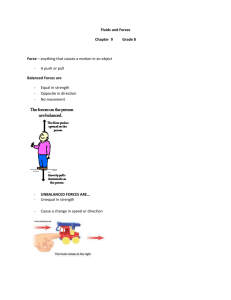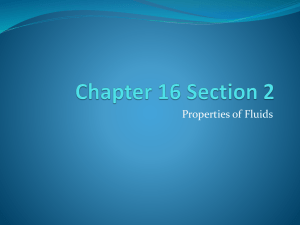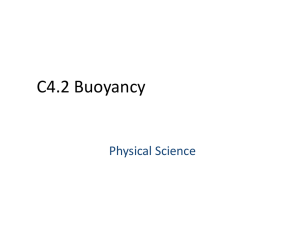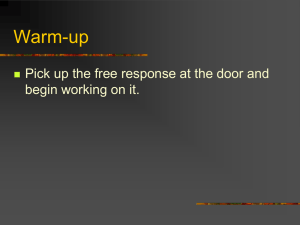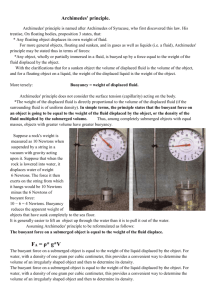NOTES_CEGE1009_4
advertisement
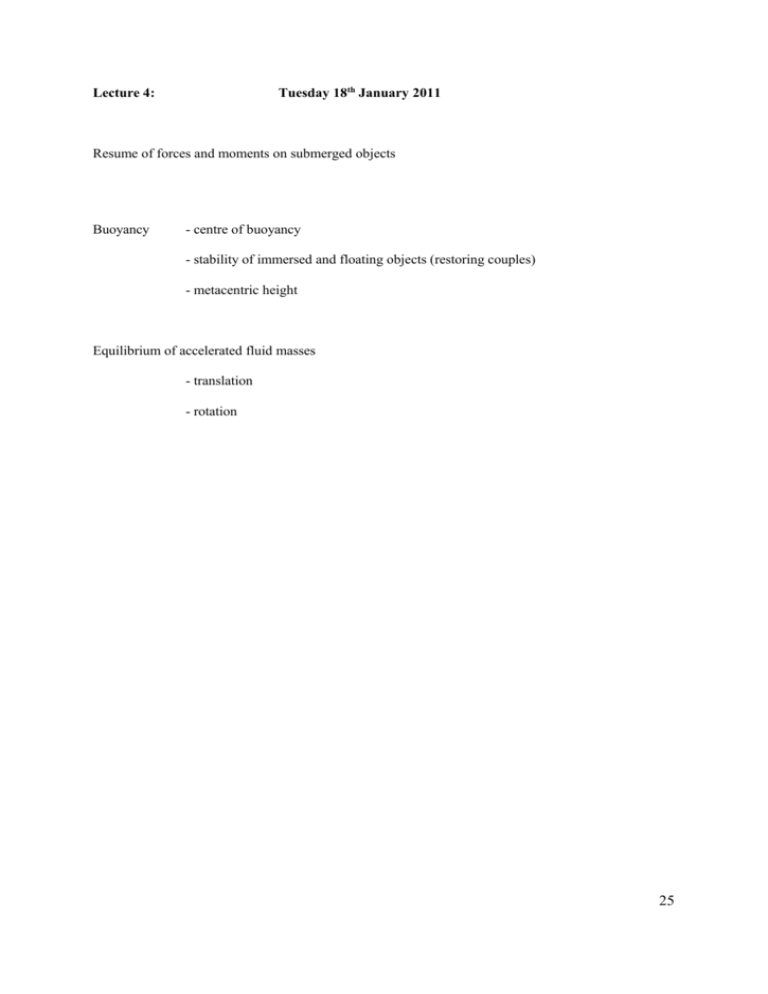
Tuesday 18th January 2011 Lecture 4: Resume of forces and moments on submerged objects Buoyancy - centre of buoyancy - stability of immersed and floating objects (restoring couples) - metacentric height Equilibrium of accelerated fluid masses - translation - rotation 25 CIVIL, ENVIRONMENTAL and GEOMATIC ENGINEERING DEPARTMENT 1st YEAR FLUIDS 2.7 CEGE1009 MECHANISMS Buoyancy and flotation When a body floats in a static fluid, the vertical forces acting on it are in equilibrium. If it is displaced upwards a small distance, the hydrostatic force supporting it (its buoyancy) is decreased so that the upward force is now less than the body's weight. There is thus a net downward force which tends to return the body to its original position. Similarly, if the body is initially displaced downwards a small distance, the forces go out of equilibrium and set up a resultant upward force which tends to restore the original position again. Such a body has vertical stability. FB Assuming that the fluid is of constant density, the upwards buoyancy force on any submerged object must act at the centroid of the fluid displaced. This point is called the Centre of Buoyancy. The weight of the object acts downwards at its Centre of Mass - and that does not necessarily coincide with the Centre of Buoyancy. The rotational stability of any body floating or submerged in a fluid actually depends on whether the rotational "couple" set up by the weight and buoyancy acting at these two points when the body is tilted tends to return it to its original position (rotationally stable) or tends to overturn it (rotationally unstable). 2.7.1 mg FB mg Totally submerged body FB Stable May be unstable FB Restoring couple = mgd d mg mg Consider the forces acting on a small submersible vessel designed with a low centre of mass: if it experiences a small angular displacement, then the couple set up tends to restore the vessel to its original orientation - and it is stable. Note that only if a fully submerged vessel has its centre of 26 mass above its centre of buoyancy will it be unstable. 2.7.2 Floating vessels FB FB M = meta-centre G mg mg Floating vessels frequently have their centre of mass above the centre of buoyancy - but most of them remain stable. This is because the centre of buoyancy moves horizontally as the floating vessel tilts, thereby again producing a couple which tends to restore the vessel to equilibrium. The point M where the line of action of the buoyancy force of the tilted vessel meets the line through the centre of mass G which was originally vertical is known as the metacentre, and the distance between the centre of mass and the metacentre, GM, known as the metacentric height. This is of particular importance to Naval Architects interested in the stability of ships, as the restoring moment is equal to [mg GM sin]. 2.8 Equilibrium of accelerated fluid masses If a body of fluid is moved at a constant velocity, then it obeys the equations derived earlier for static equilibrium. If a body of fluid is accelerated such that, after some time, it has adjusted so that there are no shearing forces, there is no motion between fluid particles, and it moves as a solid block, then the pressure distribution within the fluid can be described by equations similar to those applying to static fluids. P+P/z z az mg P P P+P/x x mg ax 27 Consider the forces acting on a small horizontal element, area A and length x, with a uniform acceleration ax in the x direction: F x = [ pA ( p + But Newton's 2nd law gives: p p x ) A ] = x A x x Fx = m a x p = ax x Now looking at the forces acting on a small vertical element, area A and length z, with a p A x = A x a x x and hence: uniform acceleration az in the z direction: p z ) A ] z A g = z A a z z p p A z A z g = Az a z and hence: = ( g + az ) z z F z = [ pA ( p + Here, pressure p, is a function of x and z, so, by definition: dp = p p x + z x z and identifying isobars as lines of constant pressure with dp = 0, we have an equation for the slope of an isobar as: dz = dx p x p z = ax ( g + a z ) It is clear that if ax =/ 0, then the isobars will not be horizontal in this case. 2.8.1 Uniform linear acceleration: g If a container of fluid is accelerated uniformly and horizontally with az = 0, then the slope of the isobars within the fluid is given by: = tan 1 a x g Remembering that hydrostatic pressure variation in a gas is negligible in comparison to that in a liquid, the free surface of a liquid is normally taken as a line of constant pressure - or isobar - and the equation above gives the surface slope of an accelerated fluid. 2.8.2 ax Uniform rotation about a vertical axis: If liquid is placed in a container and rotated about a vertical axis at a constant angular velocity, then after some time it will move as a solid body with no shearing of the fluid. Under such conditions the liquid is said to be moving as a "forced vortex" with velocity q = r at any radius r from the axis. [This contrasts with "free-vortex" motion in which the fluid velocity varies inversely with distance from the axis of rotation.] 28 ω z g A r q r r θ With constant, all fluid experiences an acceleration 2r (centrifugal) directed towards the axis of rotation, and for equilibrium of a typical small horizontal element: p r A = A r . 2 r r 2 p q = 2 r r r In the vertical direction, the usual expression for pressure distribution in a static fluid holds: p = g z Clearly, in such circumstances, the pressure is varying with both r and z: p = f(r, z),and dp = p p dr + dz r z Hence: dp = 2r. dr - g dz, and if using a liquid with constant , this can be integrated: p = 1 2 2 r 2 g z + constant This reveals that all isobars in such a rotating liquid are paraboloids with the form: r2 = k z + constant and the free surface of the liquid (being an isobar) will also take this form. 29 CEGE1009 – Mechanisms (Fluids) – Sheet 3 Density of water w = 1000 kg / m3 ; R (air) = 287 J / ( kg K ); Patmospheric at Sea Level = 101.4 kPa 1. A hollow cylinder with closed ends is 300 mm diameter and 450 mm high, has a mass of 27 kg and has a small hole in the bottom. It is slowly lowered into the water, its axis remaining vertical. Calculate the depth to which it will sink, the height to which the water will rise in it, and the gauge pressure of the air inside it. Disregard the effect of the thickness of the wall but assume that it is uniform and that the compression of the air is isothermal. [Answer: 398 mm; 16.04 mm; 3.747 kPa] 2. A rigid spherical balloon of diameter 800 mm is to be filled with helium and is intended to carry meteorological instruments to a height of 6000 m above sea level. The mass of the balloon is 0.1 kg, and the mass of the instruments, whose volume is negligible, is 0.06 kg. Assume that the balloon does not expand, that the atmospheric temperature decreases with increasing altitude at a rate of 0.0065 K/m, and that the sea level temperature is 150C. Determine from first principles the mass of helium required. [Answer: 16.9 g] 3. A rectangular gate of height 5a and width a seals a hole of the same size and shape in a vertical partition in a tank. The gate is pivoted about a horizontal axis through O, leaving 3a of the gate above O and 2a below it. The tank contains liquid of density ; on the left hand side its free surface is at a height c above the pivot O (c > 3a ), on the right hand side the free surface is level with the pivot. Both free surfaces are exposed to atmospheric pressure. Working from first principles, derive expressions for the force on the gate and the moment exerted about the pivot. Answer: F = ga2[5c-9a/2]; M = g a3 [9a - 5c/2] 4. The hinged gate formed from two rectangular elements which are rigidly attached to each other as shown in the figure is to open automatically when the water reaches a given level above the hinge. Show that this occurs when h > b 5. A circular gate of radius a in the vertical wall of a tank is hinged about a horizontal axis through its centre. The free surface of the liquid in the tank is a distance s above the gate centre (s > a) and both the free surface and the other side of the gate are exposed to the atmospheric pressure. Derive expressions for the force on the gate and the moment about the hinge, and show that the moment is independent of the liquid depth. [Answer: F = ga2 s; M = ga4 / 4] 30

